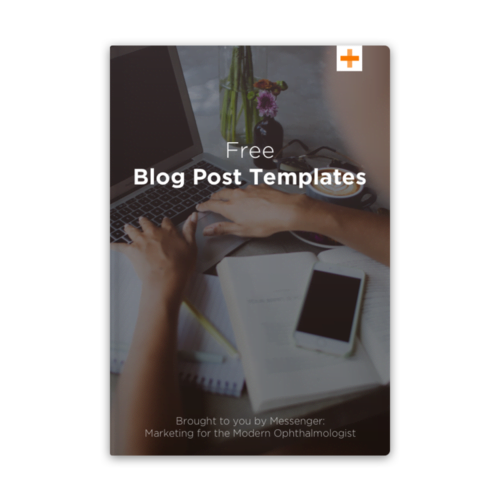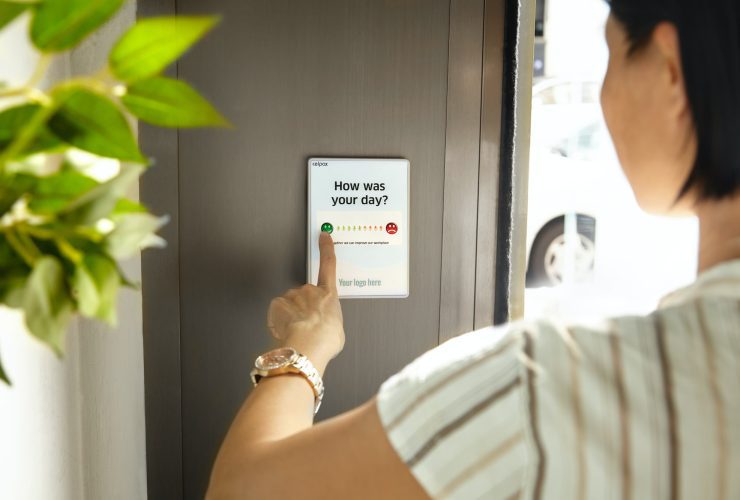How to Write a Blog Post: One Simple Formula
Unless you’re brand new to content creation, you’ve probably heard the phrase, “Content is King.” One of the best types of content to publish is a blog post. Without an active and healthy blog, your SEO will tank, you’ll have very little to say on social media, and you’ll have fewer opportunities to engage visitors with calls-to-action. But what if you don’t know anything about how to write a blog post? Where should you begin?
If you’ve ever tried blogging, you’ve likely learned that it’s hard. Nearly every physician we’ve talked to doesn’t have the time to regularly blog (even if they know it’s important). Even if they have a marketing staff at their practice to help them, their attention is spread thin as well, so often times, blogging isn’t a priority. Unless you’re one of those few people who just love writing, business blogging can be a drag.
Download our free blog post templates here to learn how to write 4 different types of blog posts.
Well, the time for excuses is over.
Blogging is the best, easiest (and cheapest!) opportunity you’ll have to increase your SEO, engage more patients, and help build your online reputation. After reading this post, you’ll have absolutely zero reasons to not be blogging every day.

Not only does this post contain best practices on how to blog, but we’ve provided some free blog post templates as well! They’ll help you create these four types of blog posts:
- The How-To Post
- The List-Based Post
- The Curated Collection Post
- The SlideShare Presentation Post
The fact of the matter is that literally anyone can blog as long as they truly know the subject matter they’re writing about. And since you’re an expert in ophthalmology, there’s no longer any reason you can’t sit down every day and hammer out an excellent blog post.
Step 1: Understand your audience.
Before you sit down to write, have a clear understanding of your target audience. Are you writing this blog post for patients, or other physicians? What do they want to know about? What will resonate?
Consider what you know about them and their interests while coming up with potential topics.
For example, if you’re writing for patients, you probably won’t want to include the same medical lingo that other ophthalmologists would understand. Likewise, if you’re sharing medical research or writing about how to grow your premium lens practice, you won’t need to worry about catering to patients as your audience.
Step 2: Start with a topic and working title.
Before you begin writing, you’ll need to pick a topic for your blog post. If you’re writing about the different types of refractive surgery as a patient education piece, you’ll want to come up with a few working titles – in other words, different ways of approaching that topic.
Not only will working titles help you narrow down your focus, but they can also help you brainstorm different topics for future blog posts and content offers. This can be done by:
- Changing the topic scope
- Adjusting the time frame
- Choosing a new audience
- Taking a positive/negative approach
- Introducing a new format
One such title could be “The Differences between LASIK and Cataract Surgery.” That may lead you to create another blog post entitled “Cataract Surgery: What to Expect,” or perhaps one called “Differences in Intraocular Lenses – Which One is Best for You?”
Step 3: Write a captivating intro.
The first sentence of your blog post is the most important – if you don’t grab the reader’s attention, they won’t stick around. They’ll stop reading before they’ve had time to give your post a fair chance, which means you won’t have a chance to engage them (no bueno).
You can kick your blog post off in a number of ways: telling an interesting story, share a fascinating statistic, or even tell a joke. The most important thing to do next is to describe the purpose of the post – and how it will address a problem the reader may be having. If they don’t know you’re going to solve their problems, they won’t keep reading.
Step 4: Organize your content.
Blog posts can sometimes be overwhelming masses of information – what’s why organization is important. Luckily, there are a few best practices to organize content that makes it easy for you to write, and even easier for your reader to consume.
Using Headings, bullet points, and organized lists are three of the best ways to organize your content. In addition, be sure to use short paragraphs (usually a sentence or two at most) for easy consumption.
To complete this step, all you need to do is outline your post. That way, before you start writing, you know which points you want to cover and the best order in which to do it. To make things even easier, you can also download and use our free blog post templates, which are pre-organized for four of the most common blog post types. It’s easy – just fill in the blanks!

Step 5: Write!
The last (but most important) step…is to write! If you haven’t already downloaded our blog post templates, you’re ready to start writing!
All you have to do is fill in the blanks for the type of post you want to create – use the outline as a guide and be sure to expand on each section. Write about what you know, be sure to include relevant facts and statistics from outside sources, and throw a few images in to keep readers engaged.
If you find you’re having trouble stringing sentences together, you’re not alone. Luckily, there are lots of tools you can lean on to help you improve your writing. Here are a few:
- ZenPen: If you’re having trouble staying focused, check out this distraction-free writing tool. ZenPen creates a minimalist “writing zone” that’s designed to help you get words down without having to worry about formatting.
- Cliché Finder: Feeling like your writing might be coming off a little cheesy? Identify instances where you can be more specific with this tool.
Step 6: Edit and Proofread
You’re almost there – but don’t forget to proofread! Nothing is worse than coming across a blog post that has lots of potential, but also lots of misspelled words, poor grammar, and the like – it’s unprofessional and will leave your readers with a less-than-ideal image of either you or your business in their mind.
Sometimes, it’s best to take a step back from your blog post and approach it in a day or two, with a fresh set of eyes and a new mindset. Don’t try to blog when you’re busy or distracted – find a quiet, distraction-free place where you can “get in the zone” and focus on creating the best content you can.
Some other things to keep in mind…
Featured Image
Make sure you choose a visually appealing and relevant image for your post. As social networks treat content with images more prominently, visuals are now more responsible than ever for the success of your blog content in social media. In fact, it’s been shown that content with relevant images receives 94% more views than content without relevant images.
Visual Appearance
No one likes an ugly blog post. It’s not just photos that make a post visually appealing – it’s the formatting and organization, too.
Headers and sub-headers are designed to break up large blocks of text, making the post easier to consume. Images shouldn’t obscure the entire page, but rather live next to words to create context and meaning.
Topics and Tags
Tags are specific, public-facing keywords that describe a post. They also allow readers to browse for more content in the same category on your blog. Refrain from adding a laundry list of tags to each post. Instead, put some thought into a tagging strategy. Think of tags as “topics” or “categories,” and choose 5-15 tags that represent all the main topics you want to cover on your blog.
Step 7: Insert a call-to-action (CTA) at the end.

Perhaps the most over-looked piece of a blog post is the call-to-action at the end. What do you want your readers to do next? Pick up the phone? Schedule an appointment? That’s the perfect opportunity for a CTA.
The bottom line? Every blog post should have a CTA at the end. Be sure to make them relevant to the topic of the post, make them visually engaging (photos are preferred over text), and make it painfully obvious (and easy) for the reader to take action.
Step 8: Optimize for on-page SEO.
After you finish writing, go back and optimize your post for search.
Don’t obsess over how many keywords to include. If there are opportunities to include keywords, go for it. Be sure to include links to relevant content in the body of your posts, and images (where appropriate).
Also, be sure your topic keyword is in the heading of your post, in the URL, and at least somewhere in the body as well.
And that’s it!
If you’ve mastered the steps above, download our free blog post templates and go do it!








